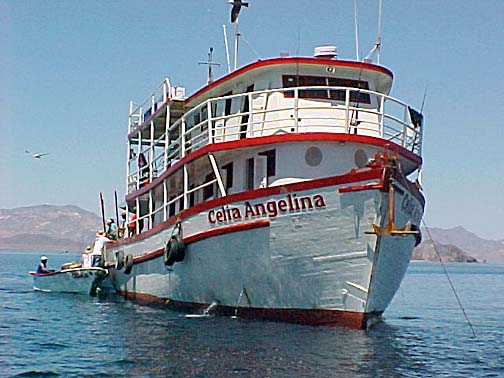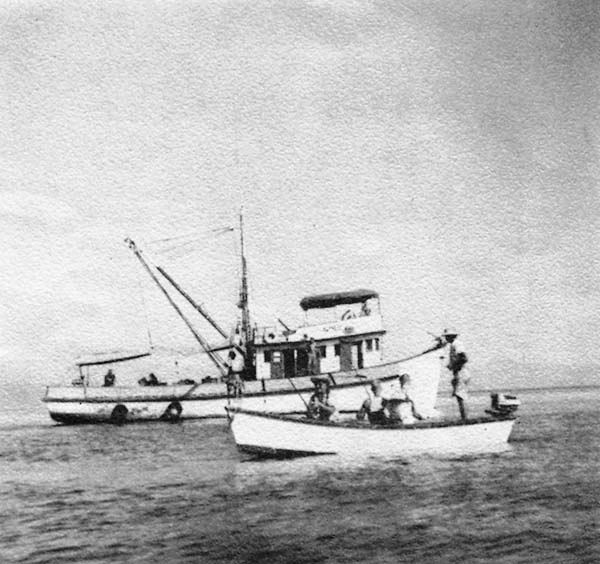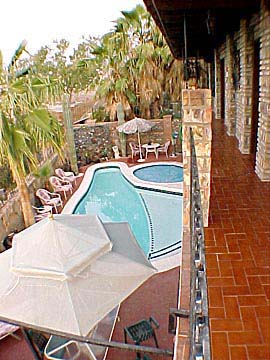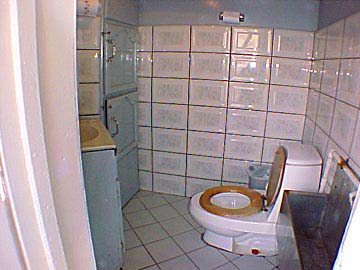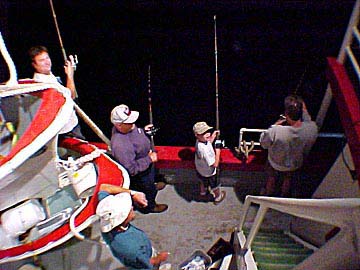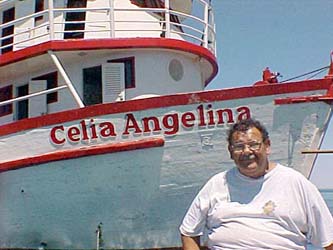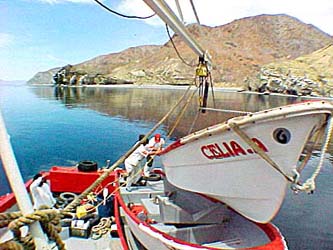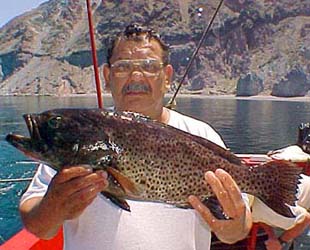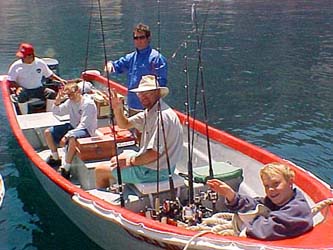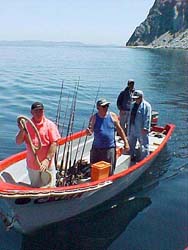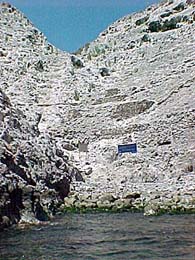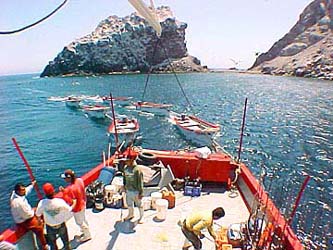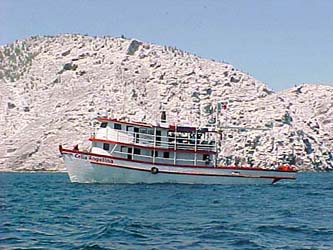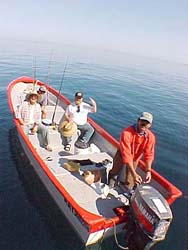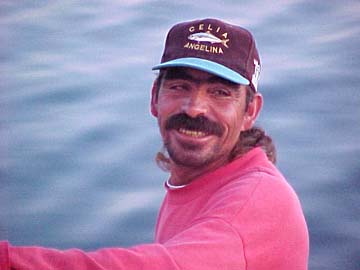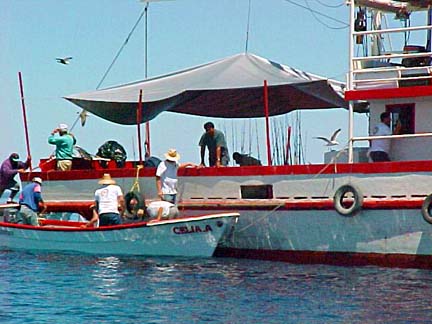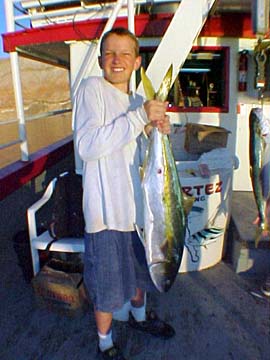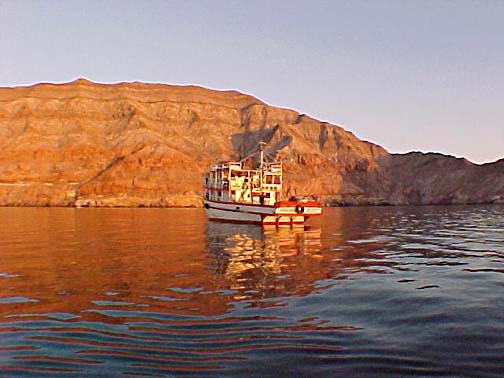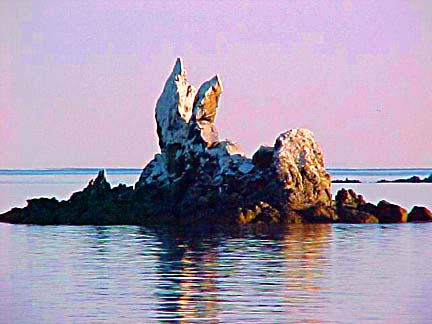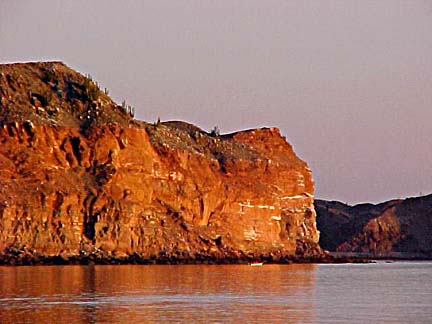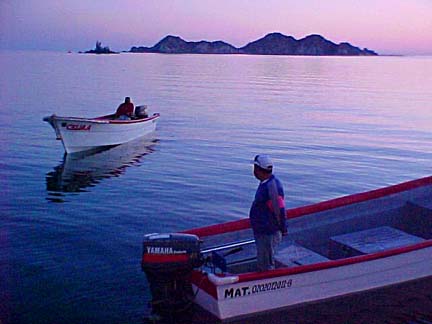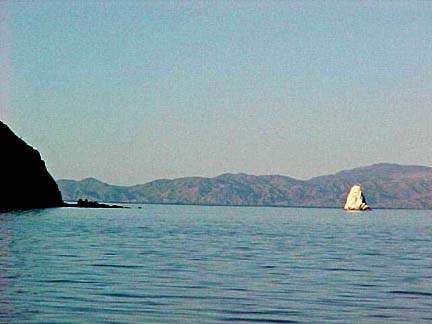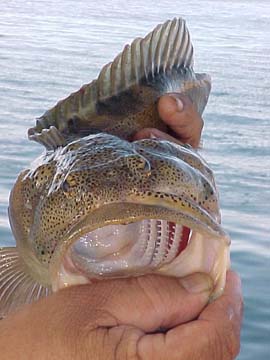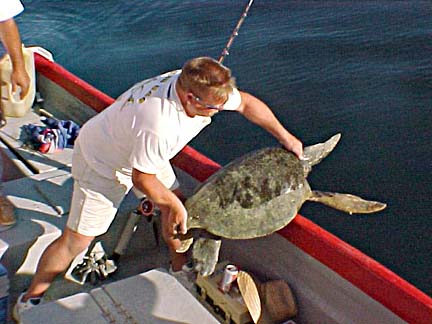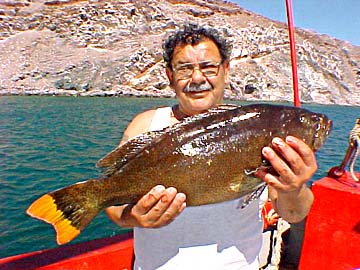
Panga Motherships of San Felipe:
The Year Of The Midriff
![]()
|
Bob Castellon's modern-day San Felipe panga mothership, the Celia Angelina, during a recent trip off Isla Tiburon, Midriff Islands, Sea of Cortez, Mexico. |
SKIFF FISHING AT MEXICO'S REMOTE SEA OF CORTEZ ISLANDS
June 12, 2000, by Gene Kira:
Many years ago, as my Baja Catch co-author Neil Kelly and I fished along the Midriff beaches of Baja California in our small "tin boats," we'd look out toward the mystical, distant Midriff islands, halfway across the Sea of Cortez, and we'd mutter things to each other like, "We're doing just fine right here," and, "Who the hell wants to go fish way out there, anyway?"
But Neil and I knew that we were really just kidding ourselves. We knew that deep down inside we would have loved to pull a Jointed Rebel along the rocks of those impossibly distant islas on the horizon: Angel de la Guarda, Tiburon, San Esteban, San Pedro Martir, San Lorenzo, and all the rest. But, as much as we wanted to, we were never foolhardy enough to risk trying to cross the dangerous Midriff channels in our frail, beach-launched craft.
This year, I have finally decided to fill that old gap in my Baja fishing experiences, and I have scheduled half-a-dozen trips to the Midriff Islands, not just any trips, but six-day San Felipe panga mothership trips, where the entire Midriff archipelago is your prime fishing grounds, where you are pampered by the guides, cooks and crews, and where you are completely free to fish, fish, fish until you drop.
|
|
For me, these panga mothership fishing trips bring some ironies, for during them I am mostly a catch-and-release angler among companions who don't consider it unusual to take home two 100-quart-plus ice chests full of fillets. I am mostly a light tackle, spinning rod, or even flyrod angler, among companions who favor roller guide sticks, two-speed lever drags, and 80-pound or heavier lines. I am a "bird-watcher" type, bent on adding new species to my lifetime list of fish caught with artificial lures, among companions who prefer fishing with live mackerel baits and whose focus is on catching just the "best-eating" fish. And finally, I sometimes don't fish at all, but prefer to snorkel, beach comb, take notes, and marvel at the beauty and magnificence of the passing scene, while many of my companions on these trips think nothing of fishing six hours in the morning, and another four or five hours in the afternoon, followed by several hours of making bait that night.
There are several of these Sea of Cortez panga motherships operating today out of the northern Cortez resort town of San Felipe, Baja California, Mexico, and they are the descendants of a kind of sportfishing that began half a century ago.
At that time, there was a place in Los Angeles called the Entz & Rucker Hardware Store, and one of its owners, Charlie Rucker, ultimately became the inventor of this Baja fishing tradition that endures almost completely unchanged to the present day.
In the 1950s, San Felipe was a dusty shrimping port of a few hundred people, about 50 commercial buildings stretched along a single street, and an ice plant on a low bluff at the north end of town. (You can still see the foundations of the old ice plant if you drive up the hill leading to the shrine above where the commercial pangas are beached today. The shaved ice from this plant was sent down a long chute directly into the shrimp boats as they lay at anchor beneath the bluff at high tide.)
There was a booming local sport fishing industry in San Felipe in the early 1950s, based on the massive schools of totoaba (totuava) that invaded the northern Cortez each winter and spring to spawn in the mouth of the Colorado River. These gigantic relatives of the white seabass grew to well over 200 pounds and were so numerous during their spawning run that they could be harpooned with ones eyes held closed. Alas, by the late 1950s, gill netting and dynamite all but wiped out the totoaba, and San Felipe's local sportfishing industry declined to the vestigial remnant that is left today: a few pangas taking a few "anglers" out to soak cut bait for small bass, croaker, and occasional corvina.
But in the early 1950s, thousands of anglers descended on San Felipe each winter and spring to catch totoaba, massive quantities of yard-long corvina, huge croaker, sierra, and an enormous variety of other fishes that swam in the waters out to Consag Rock, 18 miles straight out from town. Most of these anglers camped on the beaches at the north edge of town, near where Ruben's RV Park is today, at two places known by Americans as Camp 1 and Camp 2. (Camp 1, is still fully operational, and amazingly it is still called "Campo Uno"! You can find it near Ruben's.) Other anglers stayed at Augie's Riviera, a substantial motel which was located on the high sand dune just east of today's El Cortez Motel. This building has been enlarged as the main facility of the Riviera Resort/RV Park, but you can still see the faint outlines of the original facade of Augie's Riviera if you look closely.
San Felipe also had a local party boat, the 42-foot Marlin II, which was a converted shrimp boat that took clients out to what was still an incredible fishery, near town and out to Consag Rock. You could also fish from pangas for $5 per day, by making reservations at Carrillo's Barber Shop.
But it was Charlie Rucker who was to invent the Midriff Islands panga mothership sportfishing system that would endure to the present day. About 1952, Rucker bought two 65-foot shrimpers called the Alfredo and the Rudy, and he began taking clients 200 miles south to fish the fantastic Midriff Islands that stretched between Bahia de los Angeles and Kino Bay on the Mexican mainland. Rucker's stroke of genius was to load small pangas on the mothership and launch them at the fishing grounds. His clients and guides were then free to road and explore the reefs and really fish them, as opposed to being confined to the rails of the larger mothership. It made a tremendous difference in the enjoyment of the day and especially in the size and variety of the catch.
|
Charlie Rucker's early panga mothership, the 65-foot Alfredo, c. 1954. Reprinted with permission from The Unforgettable Sea Of Cortez. |
The fishing truly was fantastic, with incredible schools of marlin, sailfish, dorado, yellowtail, and tuna on the surface, sometimes all at the same time, and truly gigantic black sea bass and groupers that ranged to well over 300 pounds in weight lurking on the bottom nearly everywhere. In those days, a 25-pound cabrilla was considered to be a nice size for bait.
Things were a bit rough on those early boats. There were no "heads" at first (you used a bucket or hung out over the rail), not to mention showers, and clients slept wherever they could find space on the open decks. Food "service" was also primitive. An old promotional brochure for the Rudy listed among the amenities for these early trips: "...paper plates and cups, wooden forks and spoons and plastic knives; new ones each meal."
Today, San Felipe's panga motherships are larger and a lot more civilized, with air-conditioned rooms and galleys, multiple showers and bathrooms, radios, GPS, and hey, even life jackets! And the food service is excellent and ample; trust me, you don't starve on these boats! Today's modern operations include Tony Reyes' boat, the Jose Andres, Bob Castellon's Celia Angelina, Gustavo Velez' Erik, and the Captain Villegas booked by Jigstop Tours.
And the fishing? Well, one must admit that it is no longer like the "old days". Half a century of commercial and sport fishing have taken their toll on the Midriff Islands and everywhere else in the Sea of Cortez. Today, those 25-pound cabrilla are considered a "prize catch" rather than a "nice bait." Nevertheless, this is still heavy, heavy-duty fishing, and if you want to catch a waist-high pile of table fish, including some genuine big 'uns, these trips deliver reliably while you enjoy the discoveries and adventure of cruising through the magnificent and remote islands of the Midriff archipelago. And for someone like me, who loves to catch a lot of different types of fish, there is no better place to do so, maybe in the entire world, than in the swirling, intermingling cool and warm currents of the Midriff channels.
So, this year I'm spending a good part of the summer and fall--July through late October--aboard the San Felipe motherships. And if you should be lucky enough to find yourself out there in the Midriff Islands, I'll be the guy with a big smile on his face, using light tackle, or maybe a Mexican handline, and always, always looking for something new.
SAN FELIPE TO GONZAGA BAY
June 19, 2000: I love panga motherships: honest, hard-working, old, rough-and-ready, panga motherships. There are four of these converted commercial boats now sport fishing out of San Felipe, at the north end of the Sea of Cortez, and so far, I've had the pleasure of fishing on three of them.
Aboard these long-range boats, I've fished all the Midriff islands, all the way down to La Paz, and even around the tip of Baja California and up to Bahia Magdalena on the Pacific side.
I've seen fantastic mirages that made islands float up into the sky, fish pile-ups that resembled science fiction movies, storms that put green water over the top of the pilot house, and I've been privileged to witness the skill and strength of Mexican pangueros in their natural element, on the open sea with a tiller in the hand and a line in the water.
On the quiet, sweltering nights of midsummer, after everyone has gone to sleep, I've sat on deck as the anchor lights slowly brought in a swirling school of plankton to the boat. Then minnows, then small fish the size of your hand, then bigger ones, and bigger, and bigger...and one night I'll never forget, we had white seabass longer than a man's leg leaping and crashing in the lights all around us.
|
|
One night at Bahia de los Angeles, we lay at anchor off the village, hiding from a three-day northeast blow. Suddenly, about 4 a.m., the night watch and I were amazed when the wind stopped dead calm in the length of time it took for him to smoke half a cigarette. In just a couple of minutes, it became calm enough for him to blow smoke rings in the motionless air. Then, a light breeze began blowing from the opposite direction, and within 30 minutes, we were leaning into a 60-plus knot westerly, with stronger gusts that tore our anchor loose, endangering our pangas, which had been tied to the stern of the ship for the night. I will never forget the sight of our pangueros leaping into their boats, cutting them adrift, getting them started, and running them against that full gale toward the shelter of the beach. Some of them were just barely visible in the early dawn light, through a storm of blowing spindrift that rose a hundred feet above the surface of the sea and didn't come down again as it flew over the horizon. These magnificent pangueros did more than I thought a man could do. Yet, in the typical Mexican manner, nobody even mentioned it afterwards. Humbled and awestruck, I too kept my silence.
The fishing on these panga mothership trips is heavy and spectacular, perhaps the best available in Baja for a very wide variety of species. But as you might sense, for me personally, the fishing actually takes a back seat to the opportunity these motherships give you to cruise down the entire Sea of Cortez, visit remote islands, catch rarely caught types of fish, and experience the sea in a way that is otherwise nearly impossible. I simply love it.
One of the best aspects of these trips is the ability they give you to take a "snapshot" of the Cortez, from your San Felipe departure point, down to your turn-around point, which may be several hundred miles south, and then back to San Felipe. I monitor water temperatures constantly, and it's fascinating to see the changes in the readings only a few days apart. It's possible to put that data together with observations on the changing tides, and assemble a portrait of the entire Sea of Cortez at that moment. One gains a much better understanding of how it all fits together than can be developed from a series of separate trips.
The daily routine is about the same on all these motherships, and they all visit roughly the same fishing spots and anchorages during their week-long trips. They make bait in a handful of spots known to all of them. Although there are minor variations in ship size, number of pangas carried, and so forth, for all practical purposes, a mothership is a mothership.
The four boats offering weekly trips out of San Felipe are the Jose Andres of Tony Reyes Fishing Tours, the Celia Angelina of Sea of Cortez Sportfishing, the Erik of Baja Sportfishing Inc., and the Captain Villegas booked by Jigstop Tours.
Why do I love these motherships so much? In order to help explain, here's a daily photo log of a trip I took recently aboard Bob Castellon's boat, the Celia Angelina.
SIX DAYS ABOARD THE CELIA ANGELINA
I decided to drive down a day early, arriving in San Felipe about 3 p.m. on a Friday afternoon, after an uneventful border crossing at Mexicali, and a laid-back cruise down Mex 5 at my usual pace of about 50 m.p.h. The 125-mile trip seemed to pass very quickly this time, shortened by the fact that I had a passenger: another of Bob Castellon's clients. He had flown in that morning from Seattle, and it seemed that we had barely begun swapping "fish stories" when the big white arches of San Felipe swung into view. No afternoon wind. A good omen!
|
The Vista del Mar bed-and-breakfast on Mar Baltico. |
We checked in at Bob Castellon's house on Mar Jonico Street, had a tremendous Mexican dinner at George's Restaurant for about $10, and settled in for the night at the Vista del Mar bed-and-breakfast hotel owned by Jerry Kalfas. This place is located at the south end of town on Mar Baltico, and it has rooms that feel "brand new." Nice. Must admit, I was exhausted after giving a "Baja fishing" talk in Santa Barbara only 24 hours before, and I hit the sack without even trying the swimming pool. In the Vista del Mar's comfortable, air conditioned room, I slept like a fallen redwood tree under a heavy blanket of snow.
In the morning, we returned to George's Restaurant for a gigantic American-style breakfast, and then drove down to the commercial harbor where the Celia Angelina was already loading passengers. There would be a full load of 18 anglers on the trip, and the pier and boat were a massive tangle of bodies, ice chests, duffel bags, rod tubes, and big tackle boxes everywhere. Bob's crew came swarming out of this mess to help us load, and my stuff disappeared so quickly, I could only assume that it ended up on the boat (it did).
As an experiment, I had brought a tiny, 12-foot kayak along, and it too was quickly loaded and tied to the top deck of the Celia Angelina. I drove back to Bob Castellon's house, where my vehicle was parked inside the locked gate, and we all rode in a van back to the boat.
Boat departure and arrival times at San Felipe's small commercial harbor are controlled by the 20-foot tidal range of the extreme northern Cortez. At low tide, there isn't enough water to make it out the harbor entrance. At really low tide, any equipment with water intakes must be shut down to prevent sucking mud into the boat.
|
The Celia Angelina waits for the tide at San Felipe's commercial harbor. |
The tide was low, too low for departure, so we passengers waited impatiently in the bright sun while the water rose, and rose, inch by inch, and magically, the main deck of the Celia Angelina began to climb up the pier pilings. At a certain point (Bob and his skipper, Pin Contreras Montes, know it within a few inches), the water was deep enough for the Celia Angelina to clear the sandbar at the harbor entrance, and the big diesel engine was started. Our prop wash kicked up great swirls of mud from the bottom as we cast off lines and slowly swung away from the pier.
Two loud blasts of the air horn told the port captain of our departure, and suddenly, it seemed, at 10:45 a.m., the Celia Angelina slid out through the harbor entrance and pointed her bow at the brilliant blue eastern sky.
The day was perfect, and I stood at the bridge rail, leaning into a light flow of warm air, as the Celia's throttle was opened and the big boat settled into her steady, 10-knot cruising speed.
I had nothing to do for the moment but enjoy it, and to think about the week of discovery and adventure that lay ahead. It would be 5 hours to Puertecitos, 9 hours to Isla San Luis, 12 to Puerto Refugio, and 17 to the village of Bahia de los Angeles. After that, I had no idea where we would go, and I really didn't care! I was home again! On the beautiful Sea of Cortez!
GONZAGA BAY
About an hour out of San Felipe, we rounded the very shallow shoals south of Punta Estrella, giving them what always seems like an awful lot of space between us and the beach. Nevertheless, I haven't run aground on this shoal yet, so who's complaining?
This is, frankly, a rather boring stretch of coast, so I took the opportunity to refamiliarize myself with the Celia Angelina. I had been assigned a bunk in one of the three rooms on the middle deck, and I spent an hour or so sorting through my tackle and rods and spreading my sleeping bag out. I hadn't brought the recommended sleeping pillow since I always bring my own life jacket and use it instead. (This life jacket thing is a personal quirk of mine. If the water is more than three feet deep, I bring my own life jacket. I don't care if it's the QE2 or an aircraft carrier. I bring my own life jacket.)
|
"Hola!" About 450 meals will be served here during the next six days. |
Wandering around a fully-loaded panga mothership is a little like navigating a crowded dance floor, only instead of dancers, you're dodging burly anglers, folding chairs, huge ice chests, 50-pound tackle boxes, cases of soda and beer, and rods, rods, rods, all kinds of fishing rods leaning in corners, tied to the rails, laid out on bunks, all over the place. I made half-a-dozen trips through this maze, meeting the other anglers and trying to memorize names while concentrating on not tripping or accidentally kicking someone's $500 reel overboard!
About half of us on this trip would be sleeping on the Celia's outdoor bunks, which are laid out double-deck fashion in two banks of six, on the aft part of the middle deck. I've been assigned to both outdoor and indoor bunks, and I don't have a clear preference. The indoor bunks have the advantage of air conditioning, but in the outdoor bunks you are always much more keenly aware of the sights and sounds of the sea and what's going on around the boat. It's a toss-up.
I climbed down the steep stairway and circled the lower deck several times, noting the wide open engine room hatch at the bow that I've somehow never fallen down (pretty proud of that), and the renovated showers and heads nicely finished with ceramic tiles. I popped into the galley and said "hola" to the cooks, who were already preparing the first of the many really excellent meals they would serve us during the coming week.
|
Okay, it's just a head, but it's a nice one! |
Finally, I returned to the middle deck and made my way forward once again to the pilot house, where I took up a position beside Pin Contreras, our skipper, and I borrowed his binoculars as we neared Puertecitos. Little Isla El Huerfanito (The Little Orphan) came into view against the coast. It was the first of many islands that we would pass on this trip, and in my mind I visualized the entire Enchanted Island chain, then the Midriff Islands, then the Juanaloa archipelago, and finally Isla Cerralvo, the last island of the Sea of Cortez. Chatting with Pin about our planned itinerary (south, as far as Santa Rosalia), I realized that this access to the skipper and the pilot house is one of the things I enjoy most about San Felipe's motherships. This size of boat is just about perfect: large enough to provide comfort and plenty of range, yet small enough to allow an intimate feeling of participation in the nuts and bolts of the trip.
The Celia Angelina cruised smoothly south over a glassy sea, passing Puertecitos, as the sun fell into the mountains and Isla San Luis, largest of the Enchanted Islands, loomed on the glowing horizon ahead of us. At 7 p.m., we encountered an area of whales and intense early-evening bird action about two miles from the island, and we stopped to try for mackerel baits. But our Lucky Joe rigs caught nothing, so we resumed our southward journey as darkness fell.
|
Jigging for bait. Nada at Isla San Luis and Gonzaga Bay. |
Later, after dinner had been served in the galley, the boat stopped again, this time at Gonzaga Bay, and again we tried unsuccessfully to make bait as we anchored outside of Isla San Luis Gonzaga. In the pitch dark, I could see the long line of lights at Alfonsina's resort on the beach, and I recalled the many times I've driven overland to this area to camp and fish from small aluminum boats. But this time, I would be covering not just a five-mile radius from camp, but instead a tremendous four-hundred mile stretch of the Cortez.
Bob Castellon looked concerned about the lack of bait in the water. His clients depend on it for the majority of their catch, and after two stops, our live bait well held a grand total of "zero" mackerel. But, he said, we would make no more stops that night. We would cruise straight down to Bahia de los Angeles and be there by first light of dawn.
The Celia Angelina cruised south in the pitch black night, with only the stars to guide her, and I took my shower and climbed into my bunk. The droning of the big diesel engine lulled me to sleep as I fell into my memories and anticipated waking up at "L.A. Bay," scene of my first trip to Baja more than 35 years ago.
BAHIA DE LOS ANGELES & ISLA SAN LORENZO
June 26, 2000: At 5:45 a.m., the Celia Angelina dropped anchor a few hundred yards off Punta la Gringa at the north end of Bahia de los Angeles. But again, we found no mackerel baits in the 65-degree water, and we moved to the village to try again. Nothing but a couple of small spotted bay bass hit our Lucky Joe rigs, so reluctantly, Bob Castellon ordered the boat south. We would fish at our first stop, Isla San Lorenzo, with artificial lures and some of our precious cache of frozen squid.
We cruised south around sooty-black Punta Quemado (or Punta Que Malo), and were treated to the sight of a pod of huge finback whales feeding lazily between us and distant Isla Angel de la Guarda. Unlike the relatively puny California Gray Whales, these finbacks are truly gargantuan. When the head and tail come out of the water at the same time, you can hardly believe that they are attached to two ends of the same animal! Whoa! Big! Underscoring the sheer size of these whales were some kayaks that were paddling among them. They had been ferried out in a panga belonging to the La Unica wilderness resort south of Punta Soledad, and they looked like little floating crickets compared to the enormous bulk of the whales. Fortunately, these whales are usually not aggressive. Ed Gillet of Southwest Sea Kayaks says that he has had friendly encounters with them, just as with the California Grays.
|
Bob Castellon and the Celia Angelina in a quiet cove at Isla San Esteban. |
The sea between us and Isla San Lorenzo was dead flat, and the sky turned into a solid, waxy-gray overcast, as the entire Midriff archipelago swung into view. The low outlines of Islas Partida, La Raza and Salsipuedes were dominated by larger Isla San Esteban in the distance, and on the far horizon, the largest of all, Isla Tiburon, so large that it looked like the mainland of Mexico itself.
As befits the Midriff, the sea was very full of life. Schools of flying fish had been soaring through the air since about midnight, and there were baitfish and birds working everywhere. As we approached Isla San Lorezo, the binoculars revealed a light brown stain on the water about the size of a football field. The stain rose slowly a foot or two above the surface of the sea, like an enormous brown mattress floating out there, and amazingly, it turned out to be a school of giant Humboldt squid, feeding in such a dense and voracious mass that the top ones were being pushed out of the water by the ones underneath. I shuddered at the hopefully apocryphal tales I have heard of people being pulled under by these powerful predators, and of bodies being stripped to the bone in a hour's time.
|
Giant Humboldt squid caught at Isla San Lorenzo. Launching pangas at the southwest corner of the island. |
At exactly noon, the Celia Angelia dropped anchor in the shallow cove at the southwest corner of Isla San Lorenzo, and by 1 p.m., her six pangas had been launched, motors attached, clients loaded, and we began fishing the south end of the island. I had elected to fish from the big boat and my kayak during this trip, so I stayed aboard the Celia and jigged my Stingers and Krocodiles in the green, 62-degree water. On my very first drop, I was rewarded with a new species! A Pacific golden-eye tilefish. Also, the largest bigmouth bastard I'd ever seen, and a mess of spotted bay and goldspotted bass.
The pangas jigged and trolled their MirrOlure MR111s over the incredible bottom structure here, which includes underwater rocks the size of small houses, and toward evening they returned with a modest catch of giant squid, leopard grouper, sheephead, whitefish, triggerfish, spotted bay bass, and goldspotted bass. Nine species on one stop. Not bad.
|
Bob and a leopard grouper, often called a "cabrilla" by both Mexicans and Americans. Wayne Neff's panga at San Lorenzo. |
Bob Castellon was still fretting about the lack of mackerel baits, so we decided after dinner to cruise over to San Francisquito on the Baja coast. By 10 p.m., we were jigging our Lucky Joes again, with the usual result (nada), and after two hours of useless work, we pulled anchor again. For the rest of the night, the Celia Angelina would run to Isla San Pedro Martir while most of us caught up on our sleep.
SAN PEDRO MARTIR!
The instant the engine stopped, I was at the rail, peering into the black night, hoping that we had arrived at the island that I have seen so many times, but only from a distance: Isla San Pedro Martir.
We had a steady 15-knot southwest wind, and I could hear birds crying in the predawn darkness. I knew we were there, but could not see it, this, the most remote island in the Sea of Cortez.
Isla San Pedro Martir is usually observed as a very small, very distant white smudge on the horizon -- while you are heading somewhere else. It is triangular, only about a mile across and a thousand feet high, and its very steep, cliff-like sides are heavily covered with white bird guano that glistens like diamonds in the afternoon sun, but stinks like...well...bird guano, from close up... whew!
Anyway, we were there, all right!
|
At Isla San Pedro Martir. Note guano-catching rock walls and terraces, SEMARNAP sign prohibiting landing on island. |
I took my readings as the pangas were readied for fishing in the rising gray light of dawn: water temperature only 59 degrees, air temperature only 66. Cool...and a little rough. The sun came up during breakfast, and I returned to the Celia's deck to be greeted by a vertical rock wall rising straight up into the sky almost beside her. Above it, riding the updraft of the cliffs were hundreds of frigate birds, circling and wheeling in columns, and we had sea lions all around the boat and all along a rocky ledge on the nearby shore.
We got the pangas away, and I grabbed my jigging rod, hoping for another new species, but was surprised when even a Salas 6X could not reach bottom in the swift current. Now I knew why Pin Contreras had anchored so close to shore. Even tight in, almost within casting range of the cliff, we were floating in over 200 feet of water. I tried casting as far up current as possible to let my jig fall back toward me and reach bottom, but probably did not, and I caught nothing.
No matter. I was really more concerned with memorizing the cliffs and rocks here at the southwest corner of the island, and I examined carefully the intricate series of man-made rock walls and very small stone shelters that seemed to cover every inch of the cliffs. Viewed carefully with binoculars, the scope of this amazing artifact gradually emerges from beneath its cloak of guano, and one wonders at the human agony that must have been required to create it.
|
Towing pangas at the southeast corner of guano-covered Isla San Pedro Martir, most remote island of the Sea of Cortez. |
The stone walls and terraces of Isla San Pedro Martir are the result of the guano itself. They were constructed by Chinese and Yaqui indentured laborers (slaves) during the late 1800s as shelters and as guano stockpiling platforms for the collection of fertilizer that was shipped to Europe. There were as many as 200 workers living on this waterless rock at that time, and their activities and the rats they introduced nearly wiped out the island's colonies of nesting birds. Virtually the entire surface of the island was rearranged by hand in an effort to concentrate and collect as much guano as possible, and it will be hundreds of years before the ecosystem heals itself. This must have been ghastly work, indeed, and it is no wonder that the stories of San Pedro Martir as a "prison island" have become so widespread.
Our pangas returned for lunch almost empty-handed, with a few leopard grouper to five pounds, and not much else. Bob Castellon held a brief meeting during which he explained that the lack of live bait and the cool water temperatures made our planned run to Santa Rosalia impractical. If fishing were to be just as slow in the south, we would have burned up two days for nothing, and we would be faced with a long run back to San Felipe.
So, the Celia Angelina pointed her bow north again, some 100 miles short of her originally-planned turn-around point. Rather than waste precious time in a risky run to the south, we would spend our remaining days thoroughly exploring the Midriff islands in an effort to locate better fishing conditions somewhere in its infinite variety of depths and water temperatures. I had to agree with Bob's call. When things are tough, it's usually best to adapt to conditions and go with what you know usually works, and that's what we were doing.
|
Slow going in 59-degree water. After this morning's fishing, the Celia Angelia turned north in search of better conditions. |
WARM WATER AND YELLOWTAIL AT ISLA TIBURON!
JULY 3, 2000: This final portion of the log begins as the Celia Angelina turns north, short of its orginal goal of Santa Rosalia, because of cool water, slow fishing, and lack of bait, at the south end of the Midriff Area. We turn north after a relatively unproductive fishing day at Isla San Pedro Martir.
Exactly three hours after leaving the slow fishing and cool water of Isla San Pedro Martir, we dropped anchor at the long gravel bar that juts out from the southwest corner of Isla San Esteban. I took one look at the lifeless, 59-degree water, and I knew that the fishing would be no better than at San Pedro Martir. In fact, it was a little worse. Our six pangas returned to the boat with some small leopard grouper, a few small whitefish, some goldspotted bass, and a small sheephead as the most exciting catch. In a word, it was slooooow...
At sunset, we crossed the channel and returned to the south end of Isla San Lorenzo in another effort to find mackerel, or at least squid, to be used for bait, but again came up with nothing, and Bob decided to run back that night to fish the north shore of San Esteban the next morning.
|
Launching for the afternoon bite at Isla Tiburon. Two of our guides, Rocky, left, and Luis. |
Again, we caught very little. Moreover, we discovered the water on the north side of San Esteban to be a really chilly 58 degrees, fine for the immense colony of sea lions that lives there, but tough on the fishing. Despite the poor conditions, I was pleased when we added golden grouper, broomtail grouper, and a pinto bass to our trip species list.
But really, the fishing was lousy, and there wasn't even anything to look at, no weeds, no birds, nothing breaking on the surface.
In a damp mood, we pulled anchor and headed north again, this time up the west coast of large Isla Tiburon, the largest island of the Cortez. We ran up past Punta Willard, and north for two more hours, all the way to the northwest side of the island to a place called La Reina. Further up the coast ahead of us, we could see white, pyramid-shaped Isla Patos guarding the north end of Canal de Infierno.
During our three-hour run up from icy Isla San Esteban, I had noticed a really dramatic change in the water, which had turned from cold, clear blue, to a pea soup colored green, thick with plankton, and weed lines everywhere. We began to see bait balls again, and birds, and flying fish, which we had not seen since our first night. There was no doubt about it. The most life-filled part of the whole central Sea of Cortez at that moment was between Puertecitos and Bahia de los Angeles. This situation would change in a few weeks as the water warmed up, but for now the entire southern part of the Midriff was cold and dead. Bobby had been correct in his decision to turn north.
We stopped at a small rock standing off Isla Tiburon about 40 yards from shore and I took a reading: 73 degrees! This was 15 degrees warmer than the last time I had stuck the thermometer in the water that morning, only three hours before!
|
At last! Wayne Neff's two sons caught yellowtails in 73-degree water at Isla Tiburon. |
The pangas stayed out late, working our first wide open bite of yellowtail and giant squid, while I struck it rich from the boat, on triggers, two types of sculpin, goldspotted bass, and a fantastic run of super-huge bigmouth bastard, which were hitting aggressively on my Stingers.
But it was the yellowtail that made everyone happy, and there were smiles all around as we reluctantly pulled anchor and headed north to Snake Island (Isla Estanque), where we would fish the next morning.
SNAKE ISLAND
The morning bite two miles south of Snake Island (also called Isla Estanque, at the southeast corner of large Isla Angel de la Guarda), was slow again for the pangas, even though the water temperature held at 70 degrees. Nevertheless, we had a ball from the boat, pumping up our species count: popeye catalufa, conger eel, orange spotted wrasse, whitefish, some kind of red fish of the Sebastes family, and porgy, plus the usuals. An added bonus for the glassy flat morning was a spectacular display of "espejismos" or mirages, that made nearby Islas Partida, La Raza, and our old friend, San Esteban, sink, float up, disappear, reappear, and chop themselves into layer cakes or thin vertical shapes that looked like the skyscrapers of some ghostly city on the horizon.
ISLA ANGEL DE LA GUARDA
We ran north up the east shore of Isla Angel de la Guarda for the afternoon, and found 70 degree water again at Devil's Point (Punta Rocosa), where we added true red snapper (huachinango) and bat rays to our species list, plus more yellowtail and the usual cast of whitefish, goldspotted bass and leopard grouper. But fishing was rather slow overall, so after dinner, we ran at night to Puerto Refugio, the miraculous little bay at the north end of the big island. I was particularly hungry to visit this beautiful place again, which I had not seen close-up for 20 years. And that was in a Zodiac that we had run out of Bahia de los Angeles, and which popped a leak and almost swamped in a crazy, tide-ramming blow on Canal de las Ballenas. In all the years since, I had not been foolhardy enough to attempt that trip again in my various small aluminum boats.
I was again up before first light, straining to get a glimpse of this fantastically beautiful area, and I was not disappointed. As the first rays of the sun illuminated the sky, I saw that we had stopped just south of what I have always considered to be the actual "Guardian Angel" of Guardian Angel Island. This is a small white rock (also called "Fang Rock") standing at the north side of the bay, whose double pinnacles remind me of the famous Greek sculpture, Winged Victory of Samothrace. This natural sculpture is just as striking to me as the "Friars" of Punta Los Frailes at the south end of the East Cape area. Two miracles, if you ask me.
|
Remote Puerto Refugio, at the extreme north end of Isla Angel de la Guarda, clockwise from upper left: The small "Angel" rock inside the bay; a panga against the cliffs at daybreak; Roca Vela, just outside the bay; launching pangas just before sunrise. |
I asked Pin to take the Celia Angelina close to the rock, so I could photograph it in the first morning light, a thrill. But from a fishing standpoint, this "angel" might as well have been the Satan of Dante's Inferno, standing in eternity in a frozen lake, for the water at Puerto Refugio was a frigid 60 degrees, and all we could scratch up from the boat was a mess of goldspotted bass, although they were the biggest ones I've ever seen. It was interesting to see how the pattern of gold spots had changed to a more grouper-like look in these really mature fish. Some of these fish were so "different" you had to look twice to believe they were actually goldspotted bass and not something else (I don't know. Maybe they were something else).
ENSENADA GRANDE AND BACK TO SAN FELIPE
For the afternoon's fishing, we crossed over to the Baja "mainland" and stopped at "La Botica" (the pharmacy), just south of Ensenada Grande. This place got its name from the variety of medicinal plants found there, and the general greenish coloration of the shore vegetation is notable, even from a distance. With the pangas fishing and the Celia drifting almost motionless on the slack tide, I decided to have a little fun with the ubiquitous goldspotted bass, which were coming in up to seven pounds in size. I tied two Krocodiles on my 12-pound spinning rod and dropped them down the full length of the line. I mean full length. All I had left was the end-knot on the core of the spool! When the fish hit, there was so much stretch in the 2O0+ yards of light mono that I didn't need any drag. I fished with the rod held way up above my head and used my arms to "give line" when absolutely necessary. Got two big ones up to the boat that way. Har! This was the same spot where I had nailed a 17-pound yellowtail with the same rod a couple of years ago. La Botica is good medicine.
But generally, the fishing continued slow for the pangas, with a highlight of the late afternoon being a three-foot East Pacific green turtle that hit a trolled Rapala, or at least had a Rapala in its mouth when it was caught and subsequently released unharmed.
All night, the Celia Angelina cruised north toward her home port, stopping only for a few windy hours the next morning at the Golden Reef outside of the Enchanted Island chain east of Gonzaga Bay, and as we approached the end of our trip, I reflected on the sights and impressions of the past week. It had been a relatively slow fishing trip, by the standards of these panga motherships, even though we were returning with full Mexican limits for all on board, and at least a thousand pounds of prime fillets in the ice chests.
|
A few of the many unusual species caught on this trip, top row: bigmouth bastard, green sea turtle (released), conger eel. Bottom row: popeye catalufa, and a golden phase leopard grouper that didn't quite make the transition from "regular" color to gold. About 1-2% of leopard groupers make the color change and become golden groupers. |
But for me, the trip had exceeded expectations, as I had been privileged to visit very remote Puerto Refugio, Isla San Pedro Martir, and Isla Tiburon, and I had caught several new species of fish as well. Altogether, our boat had, under less than perfect conditions, caught a total of at least 27 fish species, plus giant squid and the green turtle. For my kind of fishing, new places and new species are what count most, and the Celia Angelia had provided both in spectacular fashion. That's why I come to Baja, and that's why I'm going on four more of these panga motherships between now and the end of October.
(Related San Felipe articles and reports may be found at Mexfish.com's main San Felipe information page. See weekly fishing news, photos, and reports from the major sportfishing vacation areas of Mexico including the San Felipe area in "Mexico Fishing News.")
MEXICO FISHING INFO SAN FELIPE FISHING INFO "WEEKLY MEXICO FISHING NEWS" FISH PHOTO GALLERY
